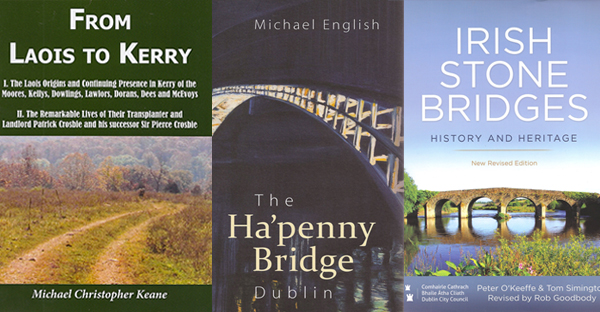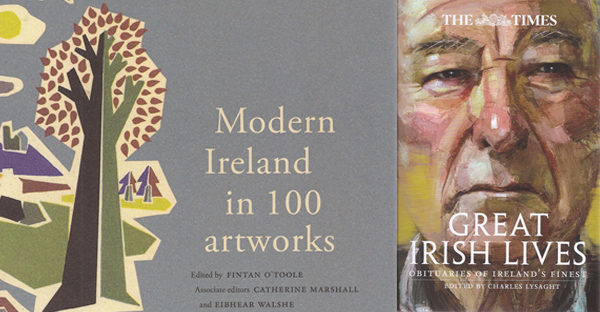BOOKWORM
Published in Book Reviews, Issue 1 (January/February 2017), Reviews, Volume 25By Joe Cully
Michael Christopher Keane, From Laois to Kerry (M.C. Keane, €20 pb, 130pp, ISBN 9780992698867).
Michael English, The Ha’penny Bridge, Dublin (Dublin City Council/Four Courts Press, €24.95 pb, 278pp, ISBN 9781907002298).
Peter O’Keeffe, Tom Simington and Rob Goodbody, Irish stone bridges: history and heritage (Dublin City Council/Irish Academic Press, €35.99 hb, 370pp, ISBN 9781911024149).
Fintan O’Toole, Catherine Marshall and Eibhear Walshe (eds), Modern Ireland in 100 artworks (Royal Irish Academy, €28.99 hb, 336pp, ISBN 9781908996923).
James Quinn and Patrick Maume (eds), Ulster political lives, 1886–1921 (Royal Irish Academy, €30 hb, 400pp, ISBN 9781908996855).
Charles Lysaght (ed.), The Times Great Irish lives: obituaries of Ireland’s finest (Times Books/HarperCollins, £12.99 hb, 400pp, ISBN 9780008211516).
Darren McGettigan, Richard II and the Irish kings (Four Courts Press, €19.95 pb, 232pp, ISBN 9781846826023).
Eugene Broderick, Patterns and patrons: the holy wells of Waterford (Waterford City and County Councils, pb, 60pp, ISBN 9780993311604).
Kenneth Ferguson (ed.), The Irish Sword (Summer 2016) (Military History Society of Ireland, pb, 360pp, ISSN 00211389).
Trevor West: the bold collegian (Lilliput Press, €25 hb, 200pp, ISBN 9781843516767).

Did you know that in the first decade of the 1600s the Seven Septs (clans) of Laois, or at least what remained of them after decades of murder, famine and general repression, were transplanted to Tarbert and its environs in north Kerry? A retired lecturer from UCC, Michael Christopher Keane, a native of Tarbert, has self-published a detailed account of the events in From Laois to Kerry. Keane makes a strong case that this ‘plantation’ was in fact a trial run for the eventual English plantation of Ireland, in particular, of course, that of Ulster. The septs—O’Moores, O’Kellys, Dowlings, Devoys, Lalors, Dorans and McEvoys—had been battling the encroaching forces of the Pale throughout Elizabeth I’s reign, but finally had succumbed and agreed to be moved. Why was the land in north Kerry largely free to accommodate the new arrivals? Because its population had been, in turn, almost wiped out by the Desmond wars of the late sixteenth century, leading eventually to the Battle of Kinsale. Keane argues that this had amounted to what we would now call ethnic cleansing, which included a (literally) scorched earth policy, with the burning of crops and slaughter of livestock encouraging a man-made famine. And central to this whole plantation business was one Patrick Crosbie (if that was his real name) and his ‘colourful’ son, Sir Pierce, and their stories are told in detail. One can’t help but think that a professional publisher, using some nice design work, judicious editing and a marketing campaign, could turn Keane’s work into a popular seller. In the meantime, you have to get it from the author at mjagkeane@gmail.com.
Could one possibly produce a nearly 300-page coffee-table book about a single bridge? With The Ha’penny Bridge, Dublin, Michael English and Dublin City Council have answered with a resounding ‘yes’. The fourth work in the council’s series on engineering history and heritage, this gorgeously illustrated large paperback addresses its subject in a series of essays touching on everything from the genesis of cast iron in the early industrial age through to the threat of demolition to make way for Hugh Lane’s museum and on to how its structure influenced the sympathetic designs of Dublin’s newest pedestrian bridges. (Equally, it does include, inexplicably, a lengthy history of Guinness’s with only the most peripheral link to the book’s subject.) The illustrations include not just the author’s fine photos but also a treasure trove of paintings, etchings and other art. Wonderful!
In 1991 two retired engineers, Peter O’Keeffe and Tom Simington, produced the monumental Irish stone bridges, which was quickly recognised as the definitive history and field guide. Now Irish Academic Press, with Rob Goodbody, have issued an updated edition, which includes over 300 new photographs (in colour this time) and introduces metric measurements where appropriate. It’s a handsome hardback and—perhaps surprisingly—immensely readable even for the uninitiated, as every bridge has behind it a story full of social history.

The Royal Irish Academy and the Irish Times have collaborated to produce the handsome and reader-friendly Modern Ireland in 100 artworks. Each piece chosen represents a year from 1916 to 2015 in an attempt to ‘trace the story of Ireland’s creative output from the revolutionary period to today’. Of those that made the cut, 27 are by women, ten are in Irish and one is an enormous state engineering project. A perfect book to dip into and suddenly lose an hour.
Also from the RIA and the Dictionary of Irish biography comes Ulster political lives, 1886–1921. Edited by James Quinn and Patrick Maume, this volume looks at 50 of Ulster’s significant political figures from the first Home Rule bill of 1886 to the foundation of Northern Ireland in 1921. All the usual suspects appear, but so too do more marginal but significant figures such as suffragist and philanthropist Margaret Byers and Denis Stanislaus Henry, a legendary barrister and MP who, despite being a Catholic, was appointed the new state’s first lord chief justice.
On the subject of biographies, Charles Lysaght has a new edition of his Great Irish lives (i.e. obituaries), including the most up-to-date figures such as Maeve Binchy, Conor Cruise O’Brien and Terry Wogan.
In the mid- to late 1390s the English king, Richard II, made two forays over to ‘his’ western isles to deal with a handful of Gaelic chieftains who were proving beyond the control of the English settlements. Chief among these ‘forgotten kings’ were Art MacMurchadha in Leinster and the Ó Neills of Tyrone and Ulster. Darren McGettigan tells the story of Richard’s endeavours in Richard II and the Irish kings. McGettigan has a simple, clear prose style, so although the early chapters, setting the scene in the Ireland of the time, drag a bit, once Richard arrives the narrative accelerates to draw in the general reader, as opposed to the merely academic.
Local historian Eugene Broderick has produced the slim but engaging Patterns and patrons: the holy wells of Waterford, of which there are now 69 of the estimated 3,000 across Ireland. Broderick opens with a clear and concise review of the history and significance of the wells, from pagan rituals to the rise of Christianity and its clever incorporation of the local native beliefs and practices. Indeed, in the early nineteenth century local clergy first attempted to suppress the patterns—too much associated debauchery—but the post-Famine church moulded the celebrations to serve its interests, including, of course, payment for indulgences. Nicely illustrated.
Among the essays included in the Summer 2016 edition of The Irish Sword, journal of the Military History Society of Ireland, is one by David Fitzpatrick on ‘Irishmen, Anzacs, and the Conflict of Empires at Gallipoli’. Other subjects addressed are ‘Three sieges and two massacres’ in Enniskillen in the 1590s and the siege of Kilkenny Castle in 1922.
Trevor West: the bold collegian is a collection of over twenty essays celebrating the life of the Trinity College academic, mathematician, senator, sports administrator and peacemaker by friends, colleagues and former students, including Mary Robinson, Seán Barrett, Ulick O’Connor, Hugo MacNeill, Paul Coulson and Michael West.

















